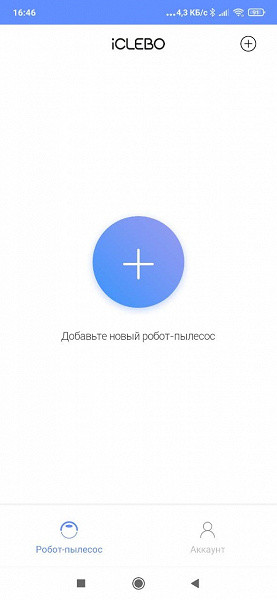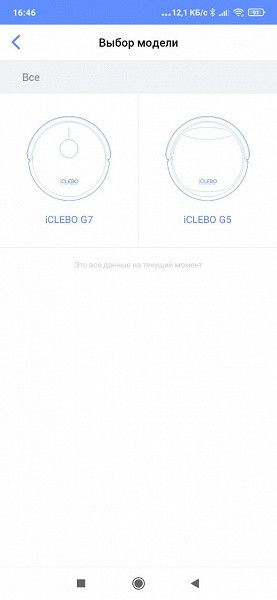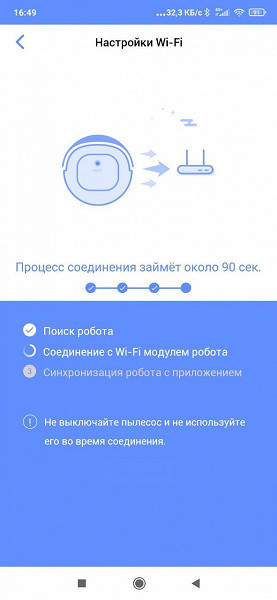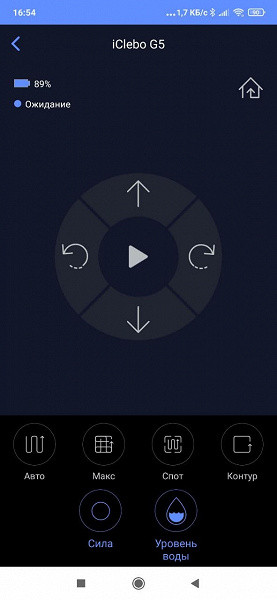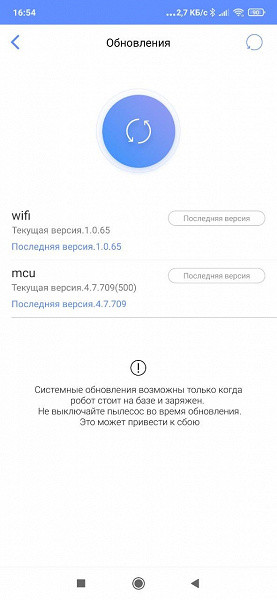The iClebo G5 robot vacuum cleaner (YCR-M09-20W) is the base model in the iClebo line. Despite the affordable price, the manufacturer claims that this robot is equipped with all modern functions for high-quality cleaning of small spaces. The model is recommended for use in spaces up to 60 square meters.
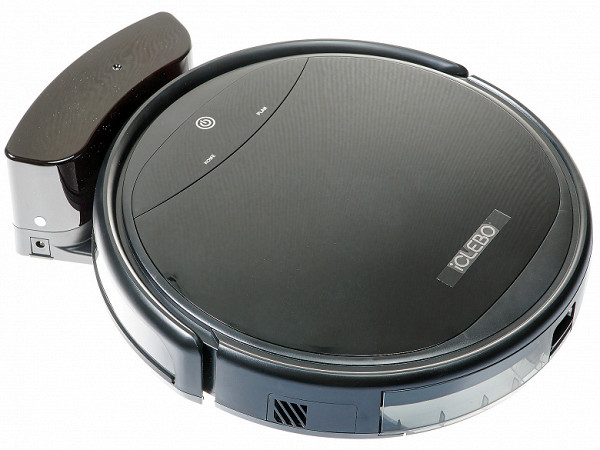
One of the key features of this device is the presence of an advanced wet floor wiping system, which we will consider separately.
Characteristics
| Manufacturer | iClebo |
|---|---|
| Model | G5 |
| Type | vacuum robot cleaner |
| Country of Origin | China |
| Guarantee | 1 year |
| Battery warranty | not specified |
| Type of cleaning | dry and wet |
| Automatic cleaning | Yes |
| Automatic return to base | Yes |
| Dust container capacity | 0.48 l |
| Noise level | <63 dB(A) |
| Maximum power | 25 W |
| Battery life | not less than 100 (up to 136 minutes, according to various sources) |
| Battery charging time | at least 5 hours |
| Battery | Li-ion, 2200 mAh, 14.4 V |
| Remote control | There is |
| Weight | 2.3 kg |
| Dimensions | diameter 335 mm, height 79 mm |
| Length of network cable | 1.4 m |
Equipment
The iClebo G5 robot vacuum cleaner comes in a brown corrugated cardboard box that looks like regular inexpensive packaging material.
However, in this case, higher quality cardboard is used. The packaging design is minimalist, using only white paint. The box presents a vector image of the device and its main characteristics, mainly in the form of pictograms.

The box looks eco-friendly, although we doubt its production is significantly different from full-color printed boxes.
For ease of carrying, the box is equipped with a plastic handle. The internal contents are packed in plastic bags and soft synthetic bags.
Inside the box we found:
- Vacuum cleaner body with electric brush, dust container, HEPA filter and primary filter
- Charging base
- Power adapter for base
- Two sets of side brushes
- Container for wet cleaning with a microfiber cloth
- Spare rag
- Remote control with AAA batteries
- Brush for cleaning the device
- Spare HEPA filter
- Restriction tape
- User Manual and Quick Start Guide
- Warranty card
- Promotional materials

Thus, the delivery set includes spare parts and consumables: a replaceable filter, a second set of side brushes (the first set is installed by the user immediately) and a replaceable rag (nozzle) for wet cleaning.
At first sight
Outwardly, our robot vacuum cleaner looks stern and serious. The sides and bottom of the case are made of matte black plastic, and the top is made of glossy black plastic. Frankly, this is a dubious decision, since the question arises of how long the device will retain its “marketable appearance.”
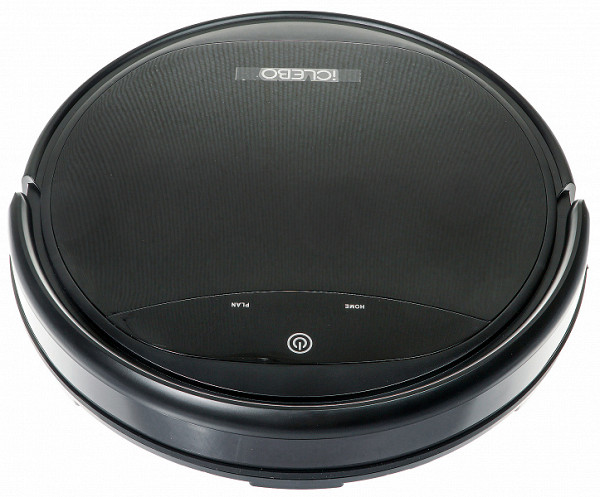
In the upper front part you can see the touch power button and two inscriptions — Home and Plan. Obviously, there are more than one buttons, but when turned off they are not visible (more on this in the “controls” section).
The vacuum cleaner body rests on three wheels: two driving and one guide.
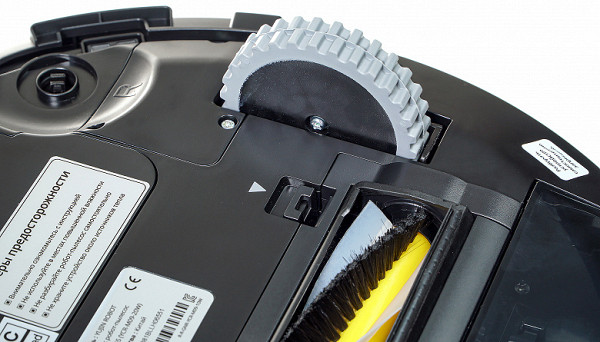
The drive wheels are equipped with rubber protectors with pronounced “lugs”, the purpose of which is to prevent slipping on smooth floors and improve maneuverability on carpeted floors.
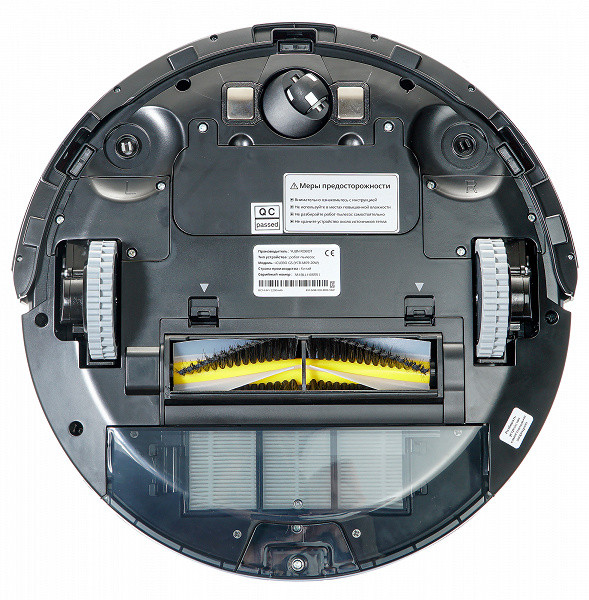
The spring-loaded suspension has a stroke of 25 mm, which allows you to change the clearance of the device from 0.5 to 3.5 cm. According to the developers, the body height is 79 mm, which allows the robot to drive under most pieces of home furniture.

The guide wheel is made of plastic and is enclosed in a plastic sphere that allows free rotation of 360°. On both sides of the wheel are contacts for charging on the base. In the front part of the body there are sockets for attaching side brushes, as well as windows for optical (infrared) surface sensors located in the center and on the sides.
In our model, the left and right brushes differ in the direction of “twisting” the synthetic hairs.

It is almost impossible to mix up the brushes and install them incorrectly: the left brush is made of gray plastic, and the right one is made of black. The connectors for attaching the brushes on the device body also have corresponding colors.
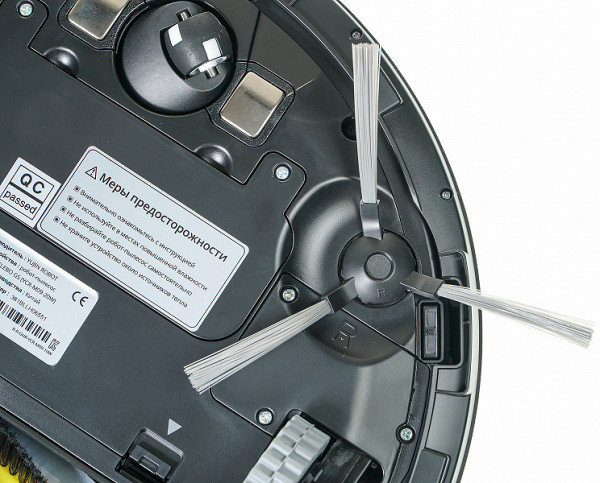
In the center of the bottom panel is the main electric brush with V-shaped rubber slats alternating with rows of synthetic bristles. It is secured with a regular plastic frame with two latches.
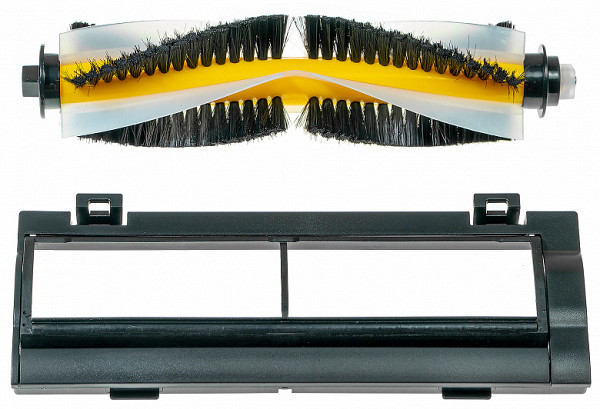
To protect the wires from winding, the brush is separated by two metal jumpers, which divide the plastic frame into two parts.
The left axis of the brush is equipped with a bearing, and the right one is inserted into the quadrangular hole of the drive. This ensures that the brush can only be installed in the vacuum cleaner in one correct way.
The switch is located on the side edge next to the right wheel. Next to the switch there is a connector that allows you to charge the device directly from the charger, without connecting to the base.
Next to the charging contacts on the base there is a battery compartment cover that is closed with two screws. The power supply consists of four 18650 batteries packed in a plastic collapsible container. The declared battery capacity is 2200 mAh. No additional information was found on the batteries themselves.
In the rear of the case there is space for installing a dust collector or a module for wet cleaning.

The front half of the side of the device is occupied by a movable spring-loaded bumper with a stroke of about 3 mm. Pressing it triggers mechanical proximity sensors. Along the entire width of the bumper there is a rubber band designed to soften impacts and collisions.
Behind the tinted glass of the bumper there are IR sensors that allow the vacuum cleaner to detect obstacles, find the base and receive signals from the control panel. Additional rear-facing infrared sensors are also installed on the fixed parts of the side wall — on the right and left.
Modules for the dust collector and wet cleaning are installed in the same slot and secured with a latch-button. The module for dry cleaning is equipped with a hinged lid that is latched with the same button, as well as a small plastic curtain that prevents debris from spilling out when carrying the module from the vacuum cleaner to the trash can. Under the cover there is a rectangular fine filter consisting of a pre-foam and HEPA element. To access the HEPA filter, you need to open another plastic cover with a latch.
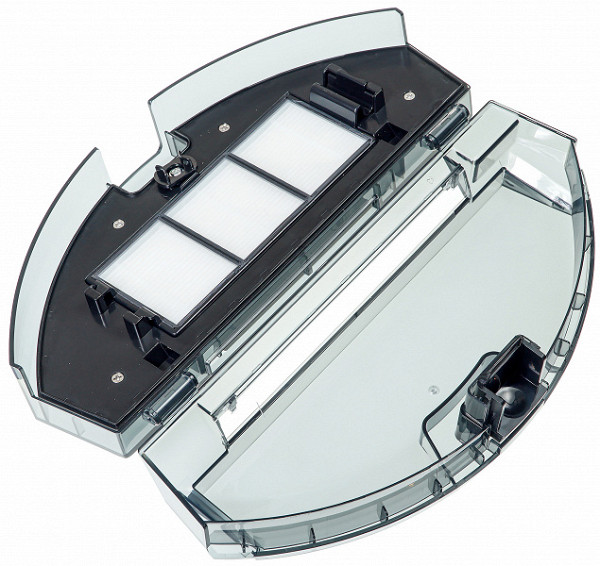
For forgetful users, a simple protection system is provided: it is impossible to assemble the module without installing a HEPA filter due to a special spring-loaded stopper that is triggered.
The module for wet cleaning includes a compartment for collecting dust and debris, as well as a container for water. It is also installed into the vacuum cleaner body using a push-button latch. The filling hole is located on the top panel of the module and is closed with a rubber stopper with a tap symbol. There is a sticker on the wet cleaning module reminding you of proper use.
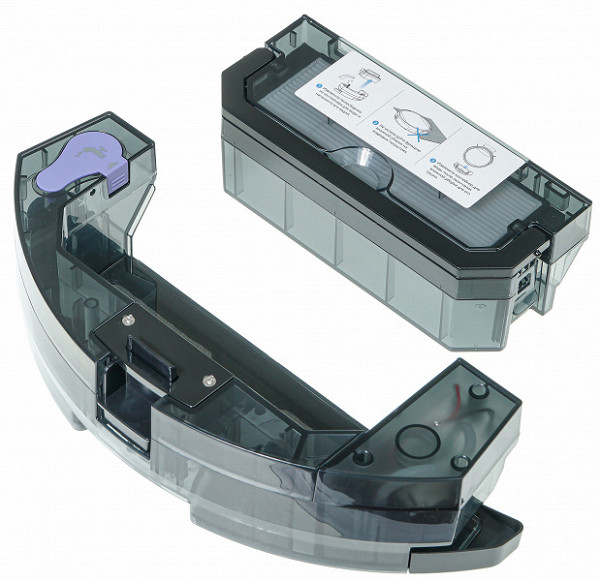
This time the container for collecting dust and debris is significantly smaller in size, but is also equipped with a HEPA filter. It can be removed using a special folding handle and installed back with a slight push and click.
The microfiber cloth is attached to the module using four Velcro strips. Water for moistening the rag comes from the tank through four holes.

The upper part of the plastic base is made of IR transparent material, under which there are sensors that ensure accurate positioning of the robot when returning to charge. There is also an LED on the base that indicates the current battery charge level. The contacts on the base are spring-loaded and have a stroke of about 3 mm.
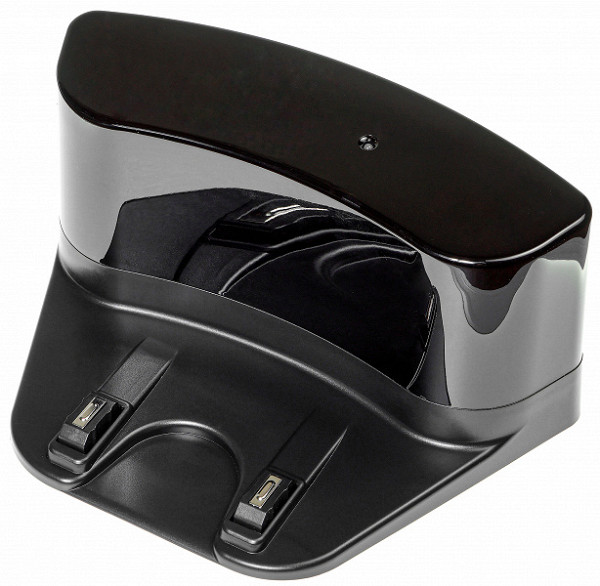
The infrared remote control runs on two AAA batteries. It is equipped with a black and white screen and ten mechanical buttons that are pressed with a characteristic click. The front side of the remote control is made of glossy plastic, but this can lead to scratches over time and deterioration in appearance.
The vacuum cleaner also comes with a special plastic brush for cleaning all elements of the device.
Instructions
The user manual consists of two A5 brochures printed on high-quality glossy paper.
The first booklet, the User's Guide, includes standard information about the device. Here you can find sections on preparing for work, using a vacuum cleaner, caring for the device, as well as possible malfunctions and their elimination. There are 28 pages in total, many of which contain useful information and illustrations, making reading the instructions an easy and enjoyable process.

The second brochure, «Quick Start Guide», provides an opportunity to quickly start using the vacuum cleaner, become familiar with the remote control (including use from a smartphone) and contains a table of error codes with methods for eliminating them.
In addition to the instructions, the robot vacuum cleaner comes with a nice card that thanks the robot for your purchase and promises an efficient cleaning service for your home.
Management
The robot vacuum cleaner is controlled by three buttons located on the top panel. The main button performs on/off/start/stop functions.

Additional buttons on the robot vacuum cleaner include the function of returning to the base (Home) and setting the current time and cleaning schedule. Pressing two buttons at the same time activates or deactivates voice prompts.
The side panel of the device has a four-digit digital display that shows the current status of the device, including time, warnings and errors.
The vacuum cleaner is turned on and off using a button on the side panel. All actions and commands are accompanied by voice messages spoken by a quiet female voice.
Remote control
The remote control is equipped with ten buttons and a liquid crystal display that displays the current time in twelve-hour format, the day of the week and the selected operating mode. If the vacuum cleaner is set to automatically clean according to a schedule, an icon will appear on the screen.
In the top row there are buttons for checking and setting the time, as well as a return to base button. In the central part there is a navigation circle for controlling the movement of the vacuum cleaner in various directions and a Start/Stop button.
At the bottom of the remote control there are buttons for selecting the cleaning mode, setting the water volume (3 modes), setting the suction power (3 modes) and increasing the suction power. The remote control is powered by two AAA batteries.
Let's note a few important points:
- There is no cleaning pause function on the remote control. You can only stop cleaning and start it again.
- The time on the remote control does not automatically synchronize with the time on the robot vacuum cleaner itself. It will have to be installed separately.
- Setting up scheduled cleaning is possible only from the vacuum cleaner itself or through a mobile application, but not from the remote control. When you turn off the power to the vacuum cleaner using the switch on the body, the schedule will be reset and will have to be configured again.
Smartphone control
The robot vacuum cleaner supports remote control through a special mobile application, provided that there is a 2.4 GHz home Wi-Fi network and the corresponding application is available on the user’s smartphone.
After installation, the application will prompt you to register by creating a username and password, as well as specifying the region.

Initial setup involves adding the vacuum cleaner to the list of home devices.
To do this, you need to find the robot in the list of various devices, then connect to the vacuum cleaner’s Wi-Fi network and transfer to it data about your home network (its name and password).
After initial setup, the application does not require any additional steps. The user gets access to all the necessary information, as well as additional functions and settings.
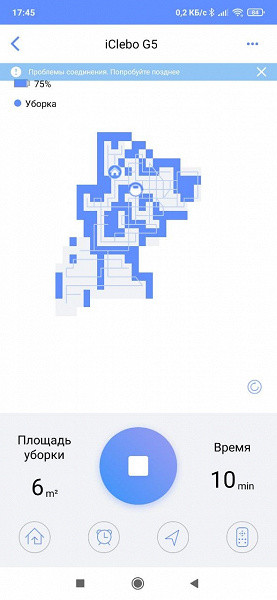
Of the most valuable information, it should be noted that the charge level of the robot vacuum cleaner is displayed. Users can also view the map that the vacuum cleaner builds during the cleaning process and see the calculated surface area cleaned. However, it is worth noting that the map generated by the vacuum cleaner during testing may look unusual. For example, even with correctly defined proportions, a polygon in reality may be rectangular, but on a map of a vacuum cleaner it may appear as a tilted parallelogram with unusual side shapes.

In addition, the application provides access to manual control of the device and the creation of complex schedules (by day of the week), which can be added and deleted independently of each other.
In “settings” you can check for updates, as well as enable or disable voice guidance.
There is also a history of errors.

And the history of completed cleanings.
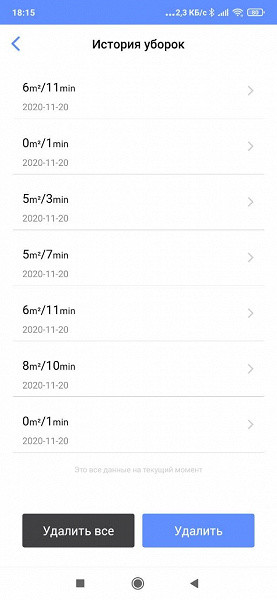
The application also has the ability to remotely turn cleaning on and off, which is convenient for users with a non-standard schedule or daily routine.
Notifications on your smartphone inform you when cleaning begins and ends, and also informs you about errors if they occur.
Exploitation
Before use, it is recommended to unpack the vacuum cleaner, remove all packaging materials, including foam rubber transport pads, and remove advertising stickers from the body.
The side brushes must be installed in their places: the right brush is on the right, the left brush is on the left. The base must be connected to the power adapter and placed so that there are no obstructions in the surrounding area.
Before the first start, it is recommended to fully charge the battery. This will take at least 12 hours as indicated in the instructions. In everyday use, the firmware monitors the battery charge and will direct the unit to the base before the charge drops to low levels that could damage the battery.
For correct operation of the remote control and vacuum cleaner, it is recommended to set the time. If you use smartphone control, the time on the vacuum cleaner is automatically synchronized with the time on your smartphone.
Through the application, you can configure the automatic start of cleaning on selected days of the week and in the selected mode.
The vacuum cleaner has several cleaning programs:
- Auto (main program): standard mode with building a map of the room and moving with a snake.
- Maximum: cleaning that goes through the room twice in different directions.
- Local: intensive cleaning of an area measuring 2 by 2 meters.
- Edge mode (cleaning along walls).
If errors occur, an error code is displayed on the vacuum cleaner display, which can be compared with the table in the instructions or read the error message in the mobile application.
In automatic mode, the vacuum cleaner randomly turns when it encounters an obstacle and builds a map of the room in real time through the application. However, in our testing, the robot's behavior was not always predictable, and the room map does not always accurately reflect the actual configuration.
If the battery charge becomes too low to return for recharging, the vacuum cleaner turns off dust suction and returns to the base. In difficult rooms, finding the base can take time, but in our tests the device did not get lost and always returned to charge successfully.
In the cleaning mode along the walls, the vacuum cleaner goes around the perimeter of the room.
When starting local cleaning, the vacuum cleaner moves concentrically from the starting point and cleans an area with a diameter of approximately 1 meter.
During wet cleaning, the vacuum cleaner not only sucks up dust, but also washes the floors. After dry cleaning of the room, it is recommended to use this mode. a tracking trace that dries quickly without streaks, drips or runs.
Care
The plastic parts of the vacuum cleaner can be wiped with a damp, wrung-out cloth or cloth. The dust container should be emptied after each cleaning to prevent it from overflowing. The HEPA filter can be washed under running water without adding any products or cleaned using the included brush. It is recommended to wash the filter no more than once a month, and dry it away from direct sunlight. It is recommended to replace the filter every 6 months.
The center brush should also be cleaned after each cleaning. The manufacturer notes that the design of the brush is sensitive to clogging by long hair, wool and threads. The brush can be cleaned with a soft cloth or rinsed under running water.
After each cleaning, it is necessary to check the axes of the side brushes for the presence of wound debris and clean them if necessary.
Regarding floor wiping cloths, the manufacturer has not provided specific recommendations. We recommend washing them under running water or using a mild detergent.
The sensors and contacts of the device should be cleaned with a dry soft cloth without using mechanical force.
Our measurements
During the entire cleaning, the robot vacuum cleaner worked in automatic mode.
In the first 10 minutes, he successfully walked around the entire test area, avoiding the “trap” in the far left corner. There was a slight delay at the start of cleaning when the vacuum cleaner required a reboot.
It is important to note that many robot models recommend that there be no obstacles around the base station within a radius of one or two meters. Our robot is not afraid of its base and confidently cleans even in its immediate vicinity.
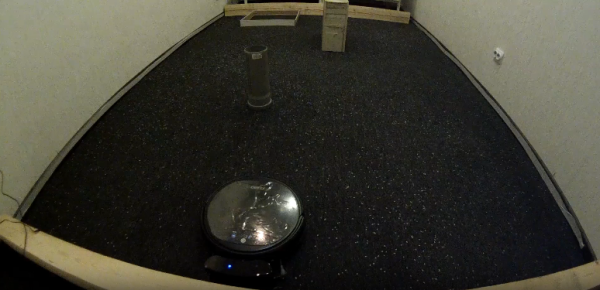
During the second ten minutes, the vacuum cleaner continued cleaning without any special incidents, visited the “trap” area, but at the end (after about 9 minutes 20 seconds) decided that the room had already been cleaned sufficiently and returned to the base on its own, despite the presence of a significant amount of “garbage” in the area. floor (we scatter 100 grams of rice evenly over the clean floor). The reasons for this behavior of the device remain unclear to us.
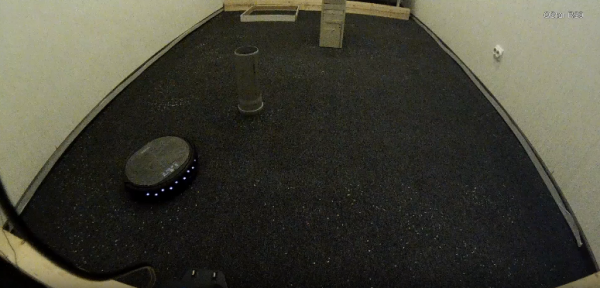
For the third decade of minutes, the robot continued cleaning as usual. After 30 minutes, it became obvious that a significant amount of debris remained near the system unit and between it and our pipe obstacle. The left side of the room also turned out to be insufficiently processed for unknown reasons.

At the fourth stage of testing, which was a 30-minute cleaning in automatic mode, the amount of garbage collected increased by another 7.7%. Although this stage was not video recorded, the conclusions are obvious: in the first half hour, the robot left quite a lot of garbage, which it later “picked up.”
As a result, the robot removed 92% of the test debris. Unlike many other models, our iClebo left quite a lot of debris not in hard-to-reach places, but practically in the middle of the room — in areas that, for some reason, it did not go through carefully enough.
| Interval | Total cleaning time, min. | % (total) |
|---|---|---|
| First 10 min. | 10 | 60.5 |
| Second 10 min. | 20 | 76.7 |
| Third 10 min. | thirty | 84.3 |
| Continuation | 60 | 92.0 |
After finishing work in automatic mode, the vacuum cleaner returns to the base and charges for about 5 hours. During this period, the base consumes about 12.8 W; in standby mode, power consumption is less than 0.1 W.
The weight of the vacuum cleaner without installed modules was, according to our measurements, 2690 grams. The dust collector unit weighs 267 grams.
The noise level in the standard mode near the vacuum cleaner did not exceed 60 decibels, in the enhanced suction mode — 62 decibels.
conclusions
The G5 robot vacuum cleaner is a well-made device, but its results were not as impressive as other models. It is assumed that the reason for this may be purely due to software aspects, perhaps due to difficulties in building a map of the room.
At first glance, the robot has all the necessary capabilities to compete with more advanced models, but in real conditions it is not very effective — sometimes it skips some areas or mistakenly believes that the room has already been cleaned, requiring a restart.
However, a positive aspect should be noted: unlike other models, the iClebo robot is not shy about cleaning near its base, which is a significant advantage.

Using a special application for smartphones on iOS or Android allows you to control the robot vacuum cleaner from almost anywhere. To achieve higher quality cleaning, the robot can be launched remotely as many times as necessary.
Pros:
- does not leave trash near the base
- large volume of waste bin
- Wi-Fi control
- convenient application
Minuses:
- mediocre quality of cleaning (not all areas of the floor are cleaned the first time)
- strange navigation and map system

